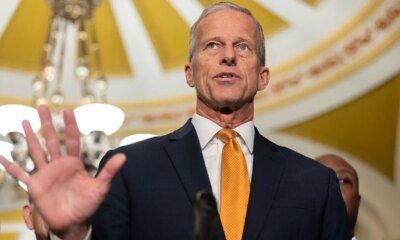News
Live news: Japanese stocks rebound from early slump

Japanese stocks made overall gains on Tuesday after an initial slump fuelled by a sell-off of semiconductor-related stocks.
The Topix benchmark was up 0.6 per cent in morning trading. Chipmakers Disco, Advantest and Tokyo Electron dropped as much as 2.5 per cent, 1.8 per cent and 0.8 per cent, respectively, before recovering.
South Korea’s Kospi index was up 0.2 per cent. Among semiconductor makers, SK Hynix rose 2.8 per cent, while Samsung SDI fell 2 per cent.
Australia’s S&P/ASX 200 added 0.8 per cent. Car accessories maker ARB rose as much as 6.2 per cent after announcing an expansion in the US, but those gains were later wiped out with the stock down 0.3 per cent.

News
National Park Service will void passes with stickers over Trump’s face

The Interior Department’s new “America the Beautiful” annual pass for U.S. national parks.
Department of Interior
hide caption
toggle caption
Department of Interior
The National Park Service has updated its policy to discourage visitors from defacing a picture of President Trump on this year’s pass.
The use of an image of Trump on the 2026 pass — rather than the usual picture of nature — has sparked a backlash, sticker protests, and a lawsuit from a conservation group.
The $80 annual America the Beautiful pass gives visitors access to more than 2,000 federal recreation sites. Since 2004, the pass has typically showcased sweeping landscapes or iconic wildlife, selected through a public photo contest. Past winners have featured places like Arches National Park in Utah and images of bison roaming the plains.

Instead, of a picture of nature, this year’s design shows side-by-side portraits of Presidents George Washington and Trump. The new design has drawn criticism from parkgoers and ignited a wave of “do-it-yourself” resistance.
Photos circulating online show that many national park cardholders have covered the image of Trump’s face with stickers of wildlife, landscapes, and yellow smiley faces, while some have completely blocked out the whole card. The backlash has also inspired a growing sticker campaign.
Jenny McCarty, a longtime park volunteer and graphic designer, began selling custom stickers meant to fit directly over Trump’s face — with 100% of proceeds going to conservation nonprofits. “We made our first donation of $16,000 in December,” McCarty said. “The power of community is incredible.”
McCarty says the sticker movement is less about politics and more about preserving the neutrality of public lands. “The Interior’s new guidance only shows they continue to disregard how strongly people feel about keeping politics out of national parks,” she said.
The National Park Service card policy was updated this week to say that passes may no longer be valid if they’ve been “defaced or altered.” The change, which was revealed in an internal email to National Park Service staff obtained by SFGATE, comes just as the sticker movement has gained traction across social media.
In a statement to NPR, the Interior Department said there was no new policy. Interagency passes have always been void if altered, as stated on the card itself. The agency said the recent update was meant to clarify that rule and help staff deal with confusion from visitors.
The Park Service has long said passes can be voided if the signature strip is altered, but the updated guidance now explicitly includes stickers or markings on the front of the card.
It will be left to the discretion of park service officials to determine whether a pass has been “defaced” or not. The update means park officials now have the leeway to reject a pass if a sticker leaves behind residue, even if the image underneath is intact.
In December, conservation group the Center for Biological Diversity filed a lawsuit in Washington, D.C., opposing the new pass design.

The group argues that the image violates a federal requirement that the annual America the Beautiful pass display a winning photograph from a national parks photo contest. The 2026 winning image was a picture of Glacier National Park.
“This is part of a larger pattern of Trump branding government materials with his name and image,” Kierán Suckling, the executive director of the Center for Biological Diversity, told NPR. “But this kind of cartoonish authoritarianism won’t fly in the United States.”
The lawsuit asks a federal court to pull the current pass design and replace it with the original contest winner — the Glacier National Park image. It also seeks to block the government from featuring a president’s face on future passes.

The America the Beautiful National Parks Annual Pass for 2025, showing one of the natural images which used to adorn the pass. Its picture, of a Roseate Spoonbill taken at Everglades National Park, was taken by Michael Zheng.
Department of Interior
hide caption
toggle caption
Department of Interior
Not everyone sees a problem with the new design. Vince Vanata, the GOP chairman of Park County, Wyoming, told the Cowboy State Daily that Trump detractors should “suck it up” and accept the park passes, saying they are a fitting tribute to America’s 250th birthday this July 4.
“The 250th anniversary of our country only comes once. This pass is showing the first president of the United States and the current president of the United States,” Vanata said.
But for many longtime visitors, the backlash goes beyond design.

Erin Quinn Gery, who buys an annual pass each year, compared the image to “a mug shot slapped onto natural beauty.”
She also likened the decision to self-glorification: “It’s akin to throwing yourself a parade or putting yourself on currency,” she said. “Let someone else tell you you’re great — or worth celebrating and commemorating.”
When asked if she plans to remove her protest sticker, Gery replied: “I’ll take the sticker off my pass after Trump takes his name off the Kennedy Center.”
News
Federal immigration agents shoot 2 people in Portland, Oregon, police say

PORTLAND, Ore. (AP) — Federal immigration officers shot and wounded two people in a vehicle outside a hospital in Portland, Oregon, on Thursday, a day after an officer shot and killed a driver in Minnesota, authorities said.
The Department of Homeland Security described the vehicle’s passenger as “a Venezuelan illegal alien affiliated with the transnational Tren de Aragua prostitution ring” who had been involved in a recent shooting in Portland. When agents identified themselves to the vehicle occupants Thursday afternoon, the driver tried to run them over, the department said in a written statement.
“Fearing for his life and safety, an agent fired a defensive shot,” the statement said. “The driver drove off with the passenger, fleeing the scene.”
There was no immediate independent corroboration of those events or of any gang affiliation of the vehicle’s occupants. During prior shootings involving agents involved in President Donald Trump’s surge of immigration enforcement in U.S. cities, including Wednesday’s shooting by an Immigration and Customs Enforcement officer in Minneapolis, video evidence cast doubt on the administration’s initial descriptions of what prompted the shootings.
READ MORE: What we know so far about the ICE shooting in Minneapolis
According to the the Portland Police bureau, officers initially responded to a report of a shooting near a hospital at about 2:18 p.m.
A few minutes later, police received information that a man who had been shot was asking for help in a residential area a couple of miles away. Officers then responded there and found the two people with apparent gunshot wounds. Officers determined they were injured in the shooting with federal agents, police said.
Their conditions were not immediately known. Council President Elana Pirtle-Guiney said during a Portland city council meeting that Thursday’s shooting took place in the eastern part of the city and that two Portlanders were wounded.
“As far as we know both of these individuals are still alive and we are hoping for more positive updates throughout the afternoon,” she said.
The shooting escalates tensions in an city that has long had a contentious relationship with President Donald Trump, including Trump’s recent, failed effort to deploy National Guard troops in the city.
Portland police secured both the scene of the shooting and the area where the wounded people were found pending investigation.
“We are still in the early stages of this incident,” said Chief Bob Day. “We understand the heightened emotion and tension many are feeling in the wake of the shooting in Minneapolis, but I am asking the community to remain calm as we work to learn more.”
Portland Mayor Keith Wilson and the city council called on U.S. Immigration and Customs Enforcement to end all operations in Oregon’s largest city until a full investigation is completed.
“We stand united as elected officials in saying that we cannot sit by while constitutional protections erode and bloodshed mounts,” a joint statement said. “Portland is not a ‘training ground’ for militarized agents, and the ‘full force’ threatened by the administration has deadly consequences.”
The city officials said “federal militarization undermines effective, community‑based public safety, and it runs counter to the values that define our region. We’ll use every legal and legislative tool available to protect our residents’ civil and human rights.”
They urged residents to show up with “calm and purpose during this difficult time.”
“We respond with clarity, unity, and a commitment to justice,” the statement said. “We must stand together to protect Portland.”
U.S. Sen. Jeff Merkley, an Oregon Democrat, urged any protesters to remain peaceful.
“Trump wants to generate riots,” he said in a post on the X social media platform. “Don’t take the bait.”
A free press is a cornerstone of a healthy democracy.
Support trusted journalism and civil dialogue.
News
Video: What Trump Told Us About the ICE Shooting

new video loaded: What Trump Told Us About the ICE Shooting

By Zolan Kanno-Youngs, Alexandra Ostasiewicz, Nikolay Nikolov and Coleman Lowndes
January 8, 2026
-

 Detroit, MI6 days ago
Detroit, MI6 days ago2 hospitalized after shooting on Lodge Freeway in Detroit
-

 Technology3 days ago
Technology3 days agoPower bank feature creep is out of control
-

 Dallas, TX4 days ago
Dallas, TX4 days agoDefensive coordinator candidates who could improve Cowboys’ brutal secondary in 2026
-

 Health5 days ago
Health5 days agoViral New Year reset routine is helping people adopt healthier habits
-

 Nebraska2 days ago
Nebraska2 days agoOregon State LB transfer Dexter Foster commits to Nebraska
-

 Iowa3 days ago
Iowa3 days agoPat McAfee praises Audi Crooks, plays hype song for Iowa State star
-

 Nebraska3 days ago
Nebraska3 days agoNebraska-based pizza chain Godfather’s Pizza is set to open a new location in Queen Creek
-

 Entertainment2 days ago
Entertainment2 days agoSpotify digs in on podcasts with new Hollywood studios

















